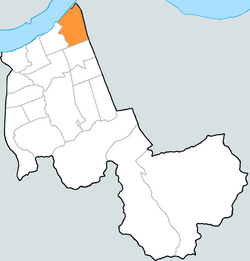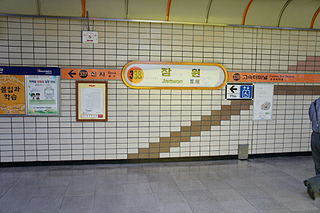
Jamwon Station (Korean: 잠원역) is a station on the Seoul Subway Line 3. It is located in Jamwon-dong, Seocho-gu, Seoul.

Sinsa station is a station on the Seoul Subway Line 3 and the Shinbundang Line. It is located in Sinsa-dong, Gangnam-gu and Jamwon-dong, Seocho-gu, Seoul. It will serve as the northern terminus of the Wirye–Sinsa Line when it is opened in 2025.
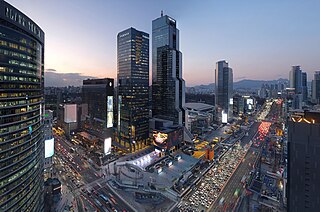
Gangnam District is one of the 25 districts of Seoul, South Korea. The term Gangnam translates to "South of the [Han] River". Gangnam District is the third largest district in Seoul, with an area of 39.5 km2 (15.3 sq mi). As of the 2024 census, Gangnam District had a population of 556,570. There is a high concentration of wealth in the district, with prices for an apartment as of 2024 more than double those in the rest of Seoul. Gangnam District is part of Gangnam School District Eight, along with the Seocho District. This district shares half of Gangnam-daero Gangnam Station area with Seocho District, which is one of the most crowded places in South Korea.

Seocho District is one of the 25 local government districts which make up the city of Seoul, South Korea. Seocho is a part of the Gangnam region, along with the Gangnam district of Seoul. Seocho District ranks as one of the richest neighborhoods in South Korea and among the most expensive areas in Seoul with an average sales price of 47.75 million South Korean won per 3.3 square meters. Many of the wealthiest residents are concentrated in the three Gangnam districts including Seocho, known as Gangnam School District Eight.

Seorae Village (Korean: 서래마을), sometimes nicknamed "Montmartre", due to its hilltop location, or sometimes "French Village", is a small, affluent French ethnic enclave in Banpo-dong & Bangbae-dong, Seocho District, Seoul, South Korea. It is home to about 560 French people, roughly 40% of the French community in South Korea. Most of them are employees of French corporations doing business in the country. The majority (370) of the French population are children.

Express Bus Terminal Station is a station on Seoul Subway Line 3, Line 7, and Line 9. The stations are located in the Greater Gangnam Area, Banpo-dong, Seocho District, Seoul, Korea.

Seocho-dong is a dong, or neighborhood of the greater Gangnam area Seocho-gu district of the South Korean city of Seoul. Seocho-dong is divided into 4 different dong which are Seocho 1-dong, 2-dong, 3-dong and 4-dong. The main street is Teheranno. There is Gangnam Station in Seocho-dong, which is one of the biggest stations in Korea.

Bangbae-dong is a dong, or neighbourhood of the greater Gangnam area Seocho District district of the South Korean city of Seoul. Bangbae-dong is divided into 5 different dongs which are Bangbaebon-dong, Bangbae 1-dong, 2-dong, 3-dong and 4-dong. The origin of Bangbae-dong is derived from the name Bangbae, meaning "dong-ri with my back to Mt. Myeon-ri," which rises on the border between Gwanak District and Seocho District. Bangbae-dong was Bangbae-ri, Sangbuk-myeon, Gwacheon-gun, Gyeonggi-do until the end of the Joseon Dynasty, but became Bangbae-ri, Sindong-myeon, Siheung-gun, Gyeonggi-do in 1914 when the area was confirmed during the Japanese colonial period. It was incorporated into the Seoul Metropolitan Government following the expansion of the Seoul Metropolitan Government's zone in 1963, and became Bangbae-dong to this day. The location is Dong at the western end of Seocho District, and it is an area from the intersection of the road from Seoul to Gwacheon City and the southern circulation road to Umyeon Mountain.
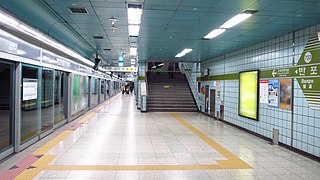
Banpo Station is a metro station on Seoul Subway Line 7 located in Jamwon-dong, Seocho District, Seoul. Despite its name, the station is not located in Banpo-dong, but instead in Jamwon. It has 6 entrances that they are all right side entrance and they have screen doors right before entering the train. It takes 4~8 minutes between 2 trains and next stations are Nonhyeon and Seoul Express Bus Terminal. It is only 500m long between Banpo station and two other Stations next to it. The station number is 733.

Yeoksam-dong (Korean: 역삼동) is a ward of Gangnam-gu, Seoul, South Korea. Teheranno runs through Yeoksam-dong and has some of the tallest buildings in Seoul, comprising a collection of corporate headquarters and high-rise office buildings.

Samseong-Dong is an affluent neighborhood or ward of Gangnam-gu in Seoul, South Korea.
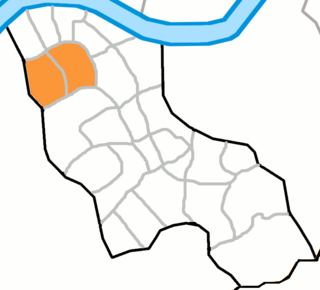
Nonhyeon-dong (Korean: 논현동) is a ward of Gangnam-gu in Seoul, South Korea. It borders Apgujeong and Sinsa-dong on the north, Samseong-dong on the northeast, and Yeoksam-dong to the south.

Irwon-dong is a ward of Gangnam-gu in South Korea.

Banpo-dong is a dong, neighborhood of Seocho District, the greater Gangnam area in Seoul, South Korea. Banpo-dong is divided into five different dong which are Banpobon-dong, Banpo 1-dong, 2-dong, 3-dong and 4-dong.
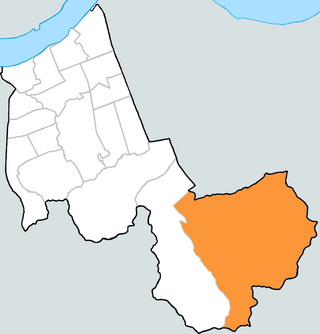
Naegok-dong is a dong, neighbourhood of Seocho-gu in Seoul, South Korea.

Yangjae-dong is a dong, neighbourhood of the greater Gangnam area Seocho District in Seoul, South Korea. Yangjae-dong is divided into 2 different dong which are Yangjae 1-dong and 2-dong.
Umyeon-dong is a dong, neighbourhood of Seocho-gu in Seoul, South Korea is part of Gangnam District and a well-known, private neighborhood for the wealthy in southern Seoul. It is a legal dong (법정동) administered under its administrative dong (행정동), Yangjae 1-dong. The first syllable of the name is derived from Umyeonsan, or Mt. Umyeon due to the geographical feature of the area has the mountain.

Hannam-dong (Korean: 한남동) is a wealthy dong (neighborhood)of Yongsan District, Seoul, South Korea. It has been portrayed continuously in South Korea's popular culture as an oasis of wealth and luxury, thus becoming the subject of numerous domestic films, television series, and popular music references.

Seobinggo-dong is a dong, neighbourhood of Yongsan-gu in Seoul, South Korea. It is directly across the river from Banpo-dong, Seocho-gu, with the Banpo Bridge connecting the two neighbourhoods.
Seoul Yangjae High School is a public high school located in Gangnam School District Eight, Seocho-dong, Seocho-gu, Seoul, Korea. This school is directly managed by Gangnam Education Office of the Government of South Korea. The Korean meaning of the school name means qualified student (良才·Yangjae). YHS is K-wave star Lee Jong-suk's alma mater and this is school chosen by many aspiring Korean top-tier students or entertainers living in the Gangnam area. The number of students per grade at Yangjae High School is about 300, around 20 percent of YHS students enter to Seoul National University, Korea University, and Yonsei University (SKY) annually. YHS campus is connected to the National Diplomatic Academy of Korea (국립외교원) and Seocho District Government Office (서초구청). Yangjae Station of Gangnam Seocho District is located right next to YHS.

